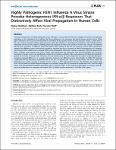Highly Pathogenic H5N1 Influenza A Virus Strains Provoke Heterogeneous IFN-α/β Responses That Distinctively Affect Viral Propagation in Human Cells
Matthaei, Markus
Budt, Matthias
Wolff, Thorsten
The fatal transmissions of highly pathogenic avian influenza A viruses (IAV) of the H5N1 subtype to humans and high titer replication in the respiratory tract indicate that these pathogens can overcome the bird-to-human species barrier. While type I interferons (IFN-α/β) are well described to contribute to the species barrier of many zoonotic viruses, current data to the role of these antiviral cytokines during human H5N1 IAV infections is limited and contradictory. We hypothesized an important role for the IFN system in limiting productive infection of avian H5N1 strains in human cells. Hence, we examined IFN-α/β gene activation by different avian and human H5N1 isolates, if the IFN-α/β response restricts H5N1 growth and whether the different strains were equally capable to regulate the IFN-α/β system via their IFN-antagonistic NS1 proteins. Two human H5N1 isolates and a seasonal H3N2 strain propagated efficiently in human respiratory cells and induced little IFN-β, whereas three purely avian H5N1 strains were attenuated for replication and provoked higher IFN secretion. Replication of avian viruses was significantly enhanced on interferon-deficient cells, and exogenous IFN potently limited the growth of all strains in human cells. Moreover, IFN-α/β activation by all strains depended on retinoic acid-inducible gene I excluding principal differences in receptor activation between the different viruses. Interestingly, all H5N1 NS1 proteins suppressed IFN-α/β induction comparably well to the NS1 of seasonal IAV. Thus, our study shows that H5N1 strains are heterogeneous in their capacity to activate human cells in an NS1-independent manner. Our findings also suggest that H5N1 viruses need to acquire adaptive changes to circumvent strong IFN-α/β activation in human host cells. Since no single amino acid polymorphism could be associated with a respective high- or low induction phenotype we propose that the necessary adaptations to overcome the human IFN-α/β barrier involve mutations in multiple H5N1 genes.
Dateien zu dieser Publikation
Keine Lizenzangabe

